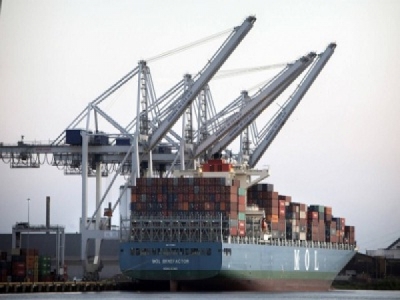
Posted on April 11, 2017
By Mary Carr Mayle, savannahnow
The project to deepen the shipping channel to the Port of Savannah is expected to cost taxpayers some $267 million more than previously estimated.
Army Corps of Engineers officials said Wednesday they now estimate that the Savannah Harbor Expansion Project — or SHEP — will cost $973 million, 38 percent more than the $706 million price tag the agency cited in 2014.
Work began in 2015 to deepen 39 miles of the Savannah River to make room for larger cargo ships to reach the Savannah port.
Army Corps Savannah District spokesman Russell Wicke said the increase can be attributed to increased dredging and construction costs, development of complex designs on unique features, and a 24-month timeline extension.
Off-setting the higher cost is an increase in the benefit-to-cost ratio, now growing to $7.30 in benefits for every $1 spent on construction, Wicke said. The previous ratio was $5.50-to-$1.
Based on this increase, SHEP is now expected to yield a net benefit of $282 million a year to the American economy, up more than $100 million a year over the previous estimate of $174 million.
That brings the total benefits to the nation over the course of 50 years to $14.1 billion, a 62-percent increase over the original 50-year estimate of $8.7 billion.
“Project benefits come mostly from transportation cost savings,” Wicke said, adding that the deepening will allow larger, more efficient vessels to call on Savannah without tidal delays.
“The fuel savings alone are immense,” he said.
Griff Lynch, Georgia Ports Authority executive director, said it’s important to look at the cost increases in light of the benefit increases.
“This is not a surprise,” Lynch said. “Any project that doesn’t start when it’s supposed to is going to run into cost increases.
“So we’re taking a one-time $267 million hit. That sounds huge until you consider that it’s less than the newly calculated annual payback of $282 million — and that’s every year,” he said.
“It’s because of that cost-to-benefit ratio that this is the Corps of Engineers’ top priority. It’s a very important project for the country.”
U.S. Sen. Johnny Isakson, R-Ga., agreed.
“For every dollar being spent on deepening the port, the Army Corps projects that the Savannah Harbor Expansion Project will bring in more than seven times that amount in net benefits for our economy,” Isakson said.
“This project has the highest cost-to-benefit ratio of any harbor deepening project in the country. We are committed to seeing this project to completion and will work with our federal partners and the state to ensure that the necessary funding is provided for an on-time completion.”
Isakson added that it’s critical that the administration include at least $100 million a year in federal funding for the Savannah Harbor Expansion so the project can stay on track.
Why increase in cost?
The cost of dredging is going up due to market forces within the dredging industry, Wicke said.
“This has resulted in an increased estimated cost of the inner harbor dredging, which is the most costly feature of the project,” he said, adding that high demand for limited dredging resources is putting upward pressure on dredging costs.
Partly contributing to this was last spring’s flooding in the lower Mississippi Valley, requiring extensive dredging operations between Baton Rouge and New Orleans.
Also, since the SHEP was authorized for construction in FY14, there have been significant changes in the project’s construction costs, Wicke said, which has resulted in the first four major contracts being awarded above the FY14 estimated value.
About half of the SHEP’s overall cost increase can be attributed to the first contracts awarded. The contract award amounts are priced at FY2015-2016 levels while the estimated costs were based on FY2014 price levels., he said, adding that the increase in market value of related, specialized services and construction also contributed to the increased costs.
Some of the cost increase is attributed to escalation involved with extending the timeline approximately 24 months to complete the project. The time it will take to complete the project has increased for a number of reasons. The primary reason can be attributed to measures that ensure contracts are awarded fairly and in keeping with the best value to the taxpayer, Wicke said.
For example, a protest on the award of the dissolved oxygen injection feature increased the project duration by several months.
Another contributor to the timeline extension is the discovery of a need for specialized work in the inner harbor during the detailed design phase. Extended timelines result in an increased cost for additional annual environmental monitoring required during construction.
“Highly complex projects of this magnitude require alignment of multiple timelines within features in order to continue making progress,” Wicke said. “Unforeseen conditions within each feature can extend the overall timeline.”
Finally, the SHEP involves several “one-of-a-kind” feature designs and construction requirements. Among them the need to conserve cultural resources such as the CSS Georgia ironclad, the scale of the Dissolved Oxygen Injection System, and special placement of dredge material from the Inner Harbor.
Also, as the project moves from conceptual to detailed designs, changes can sometimes occur that affect project costs, Wicke said, adding that an example of such changes includes additional fill material needed for sediment basin work.
Source: savannahnow





